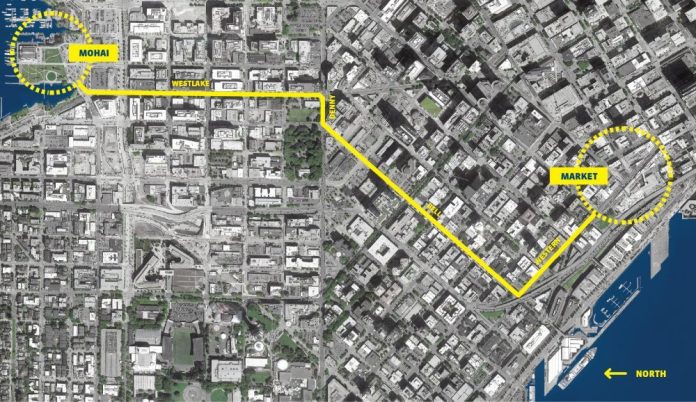A pedestrianized Ballard Avenue and protected bike lanes on Roy Street in Queen Anne were some of the street safety improvements dealt a setback this week. The Neighborhood Street Fund projects that received the most votes were revealed to the Move Seattle Levy Oversight Committee this week, and the members of that committee will be tasked with selecting which ones actually get built.
There is one caveat: the Seattle Department of Transportation (SDOT) could still eliminate projects that it deems “infeasible”–in which case a runner-up would move forward. In addition, the Levy Oversight Committee may decide to select additional projects that may offset some of the inherent inequity of the district-council based prioritization system, or prioritize those project ahead of others.
The Levy Oversight Committee also discussed the possibility of prioritizing highly-rated projects ahead of the final Neighborhood Street Fund cycle under the levy that would be scheduled to start in 2022.
In all, there were over 6,750 votes cast on the online ballot which asked people to select their favorite three projects in each council district. But the voters online skewed white, 50 years old and up, and were most likely to be voting for projects in District 6. Because this is not representative of the city as a whole, there were additional events held around town and ballots were available at Seattle Public Library branches in order to reach a broader segment of the population. This succeeded in getting around 10% of the total votes cast for Neighborhood Street Fund projects overall, but SDOT is giving projects ranked highly by that additional outreach special attention.
The three projects with the most votes for each district were:
District 1 (South Park & West Seattle)
- Delridge to West Seattle Bridge Bicycle/Trail Connections;
- Upgraded Crossings on California Ave SW; and
- Westwood Village Pedestrian Improvements.
Pedestrian improvements on Delridge Way SW were also ranked highly by the more diverse community of voters.
District 2 (SE Seattle, Georgetown, International District)
- Columbia City Intersection Improvements;
- Kubota Garden Pedestrian Improvements; and
- Connect Georgetown to South Park.
However, none of the highest ranked improvements from online voting in District 2 matched the highest ranked projects on the paper or in-person ballots. Those were:
- Rainier Beach Roundabout;
- Rainier Vista Pocket Park; and
- Beacon Ave Mobility Improvements.
District 3 (Capitol Hill, Madison Valley, north Mount Baker)
- 28th Ave E Commuter Traffic Reduction;
- Broadway and Olive/John Signal Improvements; and
- Lakeview Blvd Sidewalk Connection.
Improvements at Yesler Way and 23rd Ave S were also ranked high among the more diverse group of project voters.
District 4 (University District, Wedgwood, Ravenna)
- Connecting Roosevelt Protected Bike Lane to the Burke-Gilman Trail;
- NE 65th St Crossing Improvements; and
- NE 70th St Pedestrian Improvements.
Ravenna Ave NE Sidewalk and Bike Connection was also rated high at the additional outreach events.
District 5 (Lake City, Bitter Lake, Greenwood)
- NE 125th St Crossing Improvements;
- Broadview Traffic Calming; and
- District 5 School Crossing Improvements.
Two projects near Little Brook Park, sidewalk connections and pedestrian improvements, were rated high at the outreach events.
District 6 (Fremont, Ballard, Phinney)
- Connect 8th Ave NW to the Burke-Gilman;
- New Signal at 15th Ave NW and NW 83rd St; and
- Crossing Improvements at 22nd Ave NW and NW 65th St.
Crossing Improvements at 9th Ave NW and Leary Way were rated high at the outreach events.
District 7 (Magnolia, Queen Anne, Belltown & Pioneer Square)
- Market to MOHAI Connection Improvements;
- Sidewalk Repair at Frye Apartments on Yesler Way; and
- Denny/Stewart/Yale Intersection Improvements.
Protected bike lanes on Roy Street and W Mercer Pl sidewalk connections, both projects in Uptown, were also ranked high at the additional outreach events.
At the August 6th meeting of the Levy Oversight Committee, committee members will have already visited the sites in-person and recommended which projects get constructed in each district. Committee members are not allowed to recommend projects in their own home district. They’ll pick their top projects, likely one for each district, and then decide which districts should get a second project.
The total budget available for projects this cycle is around $4 million to $5 million, so selecting high cost projects may mean fewer get built overall. Ultimately, the need is much greater than the available funds and this very strange process (that is certainly not cheap in itself) is a questionable use of levy funds after the scaling-back that has occurred in other programs. Rather than trying to balance it out with forced equity considerations, perhaps starting from the point of equity in the first place makes more sense.
Ryan Packer has been writing for The Urbanist since 2015, and currently reports full-time as Contributing Editor. Their beats are transportation, land use, public space, traffic safety, and obscure community meetings. Packer has also reported for other regional outlets including BikePortland, Seattle Met, and PubliCola. They live in the Capitol Hill neighborhood of Seattle.


